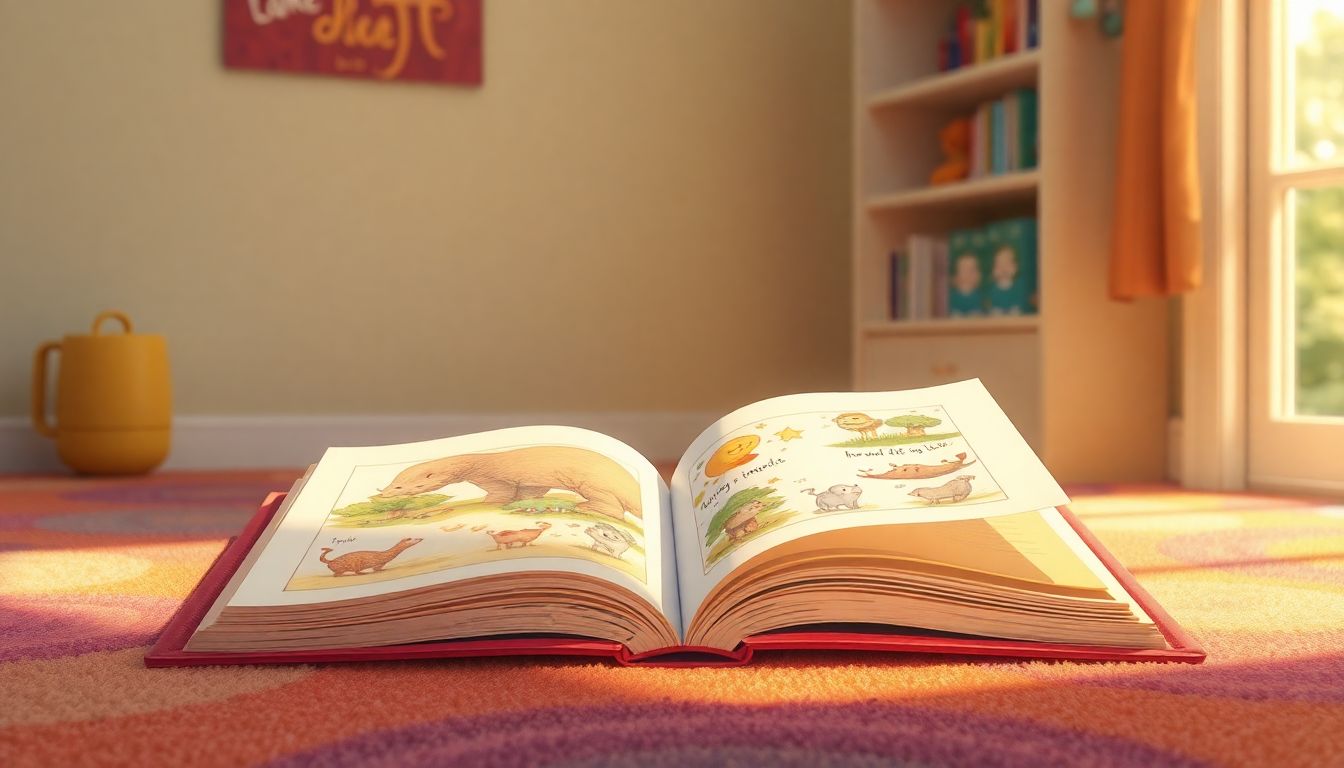Publishing a children’s book might feel overwhelming at first—the writing, creating illustrations, formatting, and figuring out the publishing market can all seem like one giant puzzle. Plus, you’re probably wondering if your story is charming enough or if anyone beyond grandma will buy it (no offense, grandma!). Trust me, we’ve all been there.
But here’s the good news: If you stick with me through each straightforward step, you’ll soon realize publishing your children’s book is definitely doable. You’ll have a clear roadmap that helps you turn your lovely idea into a finished book kids (and their parents!) will happily read.
Ready? Let’s jump right into it.
Key Takeaways
- Start by writing a clear, engaging story tailored toward kids’ reading levels (around 400-800 words); consider trending themes like mental health or diversity.
- Choose the format carefully: paperbacks for affordable, casual reading; hardcovers for durability; ebooks for interactive digital features.
- Illustrations are key—pick or create simple, bright images suitable for your target age; Fiverr or Behance can help find affordable illustrators.
- Format your book professionally—stick to standard children’s sizes (like 8×10″), use kid-friendly fonts, and ensure high-quality images (300 DPI).
- Select a publishing platform (like Amazon KDP for simplicity or IngramSpark for broader reach), get unique ISBN numbers for each format, and always review a proof copy before publishing.

Step 1: Write and Edit Your Children’s Book Story
When it comes to publishing a children’s book, everything starts with a great story, so your first and most crucial step is to write and edit a compelling manuscript for kids. Aim for a clear theme or moral that kids will understand, coupled with engaging characters and relatable situations.
Start by brainstorming ideas around trending themes for 2025 like diverse storytelling, mental health topics, or eco-friendly lessons to resonate with contemporary readers. Give children engaging writing prompts to spark creativity if you’re stuck or need inspiration.
When crafting your story, use simple words and concise sentences to accommodate your young audience’s reading level. Aim for tight, meaningful text—most children’s picture books range from just 400 to 800 words in length.
Once your draft is complete, it’s time to edit thoroughly. Read your manuscript aloud to spot awkward phrasing or sentences that are too complex. Watching a child’s reaction or asking kids for feedback can dramatically improve your editing process.
You may also consider hiring professional editors or beta readers who specialize in children’s books to ensure your book aligns with market standards while maintaining your unique voice. If you’re unsure about connecting with professional editors, check out this guide on how to get a book published without an agent, which includes tips on editing and polishing your work independently.
Step 2: Decide on Your Book’s Format (Paperback, Hardcover, Ebook)
Choosing the right format is key to how well your children’s book will be received by readers and how well it will sell. Today’s children’s book market is booming, projected to hit over $12 billion worldwide by 2025, growing steadily due to an increased attraction toward ebooks, audiobooks, and interactive formats.
Consider your audience carefully—print books are excellent for younger kids because tactile engagement boosts learning and enjoyment. Board book sales have grown by 20% since 2013, reflecting their popularity among parents and grandparents for young children due to durability and encouragement of early interaction with books.
Paperback versions tend to be budget-friendly and lighter for kid-handling, perfect if you’re looking to encourage casual reading. Hardcovers, meanwhile, offer durability and are often bought for gifts, collections, and libraries.
If budget or convenience is important, ebooks are an excellent solution since they require lower upfront investment and can easily feature interactive features such as clickable areas and sound effects. Check out how to create an interactive ebook for free to open a new avenue for reaching young, tech-savvy readers.
Step 3: Create or Choose Illustrations for Your Children’s Book
Pictures truly make a children’s book come alive, so choosing the right illustrator or developing your illustrations matters greatly. Even if your story is fantastic, visual appeal dramatically influences sales and reader interest, especially among young kids.
You have the option to illustrate your book yourself if you’ve got the skills, or you can hire a professional illustrator whose style complements your story type. Sites such as Behance or Fiverr are fantastic places to check illustrators’ portfolios, styles, and pricing to fit your needs and budget.
Before hiring, make sure the illustrations match the age group you’re targeting; younger children prefer bright, simple, and cheerful graphics, while older children might appreciate detailed drawings or artistic styles. You can even test preliminary sketches with children in your target age group for honest, immediate feedback that will guide your illustration choices.
Always ensure illustrations leave sufficient room for text placement without obstructing or distracting from reading flow. Additionally, remember the importance of maintaining visual consistency—characters and backgrounds should look coherent from page to page.
Consider including diverse characters, which resonate with audiences and align with the current market trend toward inclusive storytelling in children’s literature.

Step 4: Format Your Book for Publishing (File Requirements)
Formatting your children’s book correctly really matters because otherwise your book might look messy or unprofessional when printed or viewed digitally.
First off, decide on your book’s dimensions—popular sizes for kids’ books are usually 8.5×8.5 inches or 8×10 inches, which are easy for little hands to handle.
For print books, you’ll typically use PDF files ensuring all images are high-resolution (at least 300 DPI).
Include proper margins—usually at least 0.5 inches—to prevent text and images from being accidentally trimmed off.
When placing text, pick kid-friendly fonts like Comic Sans, Century Gothic, or Arial, but check out this handy guide about the best fonts for book covers for extra insight.
Ebooks have different requirements—formats like EPUB and MOBI don’t always support fancy layouts, so keep your design simple and test thoroughly on devices like Kindle before publishing.
If your ebook includes interactive features, double-check click areas, and make sure audio or animations run smoothly on different devices and screen sizes to avoid complaints later on.
Step 5: Choose a Publishing Platform and Register Your Book
Picking the right publishing platform helps you get your book out there without unnecessary headaches.
Amazon KDP remains super popular due to its ease of use, widespread distribution, and dominance in online sales for self-published authors.
However, alternatives like IngramSpark are perfect if you want your children’s book available to independent bookstores and libraries since they offer broader distribution channels.
If you’re not sure which one to use, here’s a helpful comparison about self-publishing on Amazon KDP: pros and cons.
Once you’re settled on a platform, registering your book involves obtaining an ISBN number, essential for tracking sales and getting your book into retailers and libraries.
You can get a single ISBN or purchase in bulk from providers like Bowker—but remember, every format (ebook, paperback, hardcover) needs its own unique ISBN.
Step 6: Order and Review a Proof Copy of Your Book
Never skip ordering a proof copy, seriously—it’s your chance to see how your children’s book actually turns out and catch problems before customers do.
Through platforms like Amazon KDP and IngramSpark, you can order low-cost single proof copies.
Check carefully for issues like fuzzy illustrations, blurry text, or alignment errors, and then adjust your file accordingly before you hit publish.
Also, get feedback from kids—hand the proof to your nephew or your friend’s kid and see how they naturally interact with it.
Trust me, nothing beats watching a kid stumble over unclear text or confusing images to help you reconsider layouts and flows.
Step 7: Publish Your Children’s Book and Start Promoting it
Publishing your children’s book officially puts it out into the world, so celebrate—but don’t sit back because promotion is essential to getting sales.
Create a compelling Amazon book page by writing an engaging description, using eye-catching images, and selecting strategic keywords that help your book show up in customer searches.
Consider running launch promotions like free ebook days or discounted pricing using Amazon’s KDP promotional tools to build early buzz.
You can even create a simple author website using an easy-to-use platform like Wix or Squarespace (here’s a guide on the best website builder for authors) to showcase your book and tell potential readers more about you.
And don’t forget social media—Facebook groups for parents, Instagram stories, and Pinterest boards targeting kid-friendly activities are fantastic places to attract interested readers.
Step 8: Analyze Sales and Improve Your Marketing Strategies
Once your children’s book has been live for a bit, reviewing your sales data tells you what’s working and where you might need to change things up.
Amazon KDP provides useful dashboards showing unit sales, royalties earned, and even which countries your book is selling best in.
If ebook sales are low but paperback sales sparkle, that might be a clue about adjusting price points or doubling down on your print-edition promotions.
You might notice seasonal patterns—children’s book sales usually spike around holidays or back-to-school periods—so plan promotions or social media pushes to capitalize on that.
Stay open to experimentation, and be ready to tweak your listings, description, keywords, and social media strategy until you’re happy with sales figures.
Frequently Asked Questions About Publishing Children’s Books (Optional)
Thinking practically, here’s a super-fast lightning-round of answers to questions that always pop up:
- How long should a children’s book be? Aim for 24-32 pages for picture books, around 400-800 words.
- What’s the ideal price range? Typically, ebooks range $2.99-$4.99, paperbacks $9.99-$12.99, and hardcover books around $14.99-$19.99.
- Do I need an illustrator? Absolutely, unless you are skilled enough yourself—quality illustrations strongly impact sales.
- What topics sell best? Hot trends for 2025 include diverse storytelling, mental health for kids, interactive formats, eco-friendly themes, and personalized books. Here’s a good resource for kids’ topic inspiration.
- Can I make money from childrens’ books? Absolutely! But realistically, developing an audience and generating consistent profits takes time, patience, promotion, and continuous improvement.
Publishing a children’s book independently can feel a bit intimidating, but by following these practical steps, staying flexible, and refining as you go, you’ll set yourself up for a fun, fulfilling creative journey and—who knows—maybe even a profitable one, too!
FAQs
Paperback is cost-effective, while hardcover feels more durable and appealing as gifts. Ebooks reach digital-savvy families easily. Consider your target audience, pricing goals, and intended distribution channels before selecting a format that suits your story best.
Professional illustrations help your book stand out and attract young readers’ attention, enhancing storytelling. While you can use self-created imagery or stock illustrations, professionally drawn images significantly boost reader appeal, credibility, and overall book quality.
Select a platform based on factors like cost, royalty rates, distribution reach, ease of use, and support. Popular choices include Amazon KDP, IngramSpark, and Lulu. Compare options carefully to find one that meets your specific publishing needs and budget.
Effective strategies for marketing children’s books include hosting author readings at schools or libraries, reaching out to parenting blogs, building an engaging social media presence, offering book giveaways, and obtaining positive reviews from influencers and trusted book reviewers.
